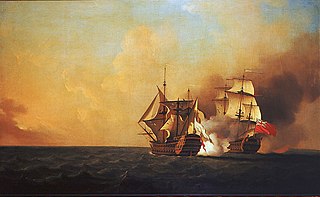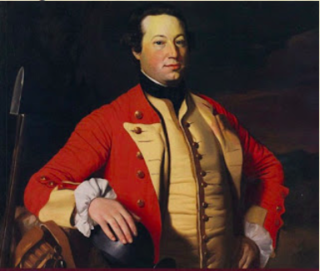
General James Abercrombie or Abercromby of Glassaugh, Banffshire was a British Army general and Whig politician who sat in the House of Commons from 1734 to 1754. He was commander-in-chief of forces in North America during the French and Indian War, best known for the disastrous British losses in the 1758 Battle of Carillon.
Christopher Middleton was a British navigator with the Hudson's Bay Company and Royal Navy officer. He was elected a Fellow of the Royal Society on 7 April 1737.

Jacques-Pierre de Taffanel de la Jonquière, Marquis de la Jonquière was a French admiral who was appointed as Governor General of New France, where he served from 1 March 1749 until his death in 1752.
James Webb was an officer of the Royal Navy, who served as colonial governor of Newfoundland. He was born in England, and died at Plymouth Sound.
Richard Dorill was a naval officer and colonial governor of Newfoundland, died in Bath, England.

Vice Admiral Charles Watson was an officer of the Royal Navy, who served briefly as colonial governor of Newfoundland, and died in Calcutta, India.
Wager Bay or Ukkusiksalik Bay is long narrow inlet in the Kivalliq Region of Nunavut, Canada, which opens east into Roes Welcome Sound at the northwest end of Hudson Bay. Ukkusiksalik National Park surrounds it.
Louis Fornel was a Canadian merchant, explorer, and seigneur in New France. Involved in maritime trade and both born and married into prominent Quebec families, Louis Fornel was among the partners Louis Bazil convinced to invest in his ill-fated Labrador sealing station.

Augustin de Boschenry de Drucour or de Drucourt was a French military officer, who led the French defence in the Siege of Louisbourg.

John Barnard was a Congregationalist minister from Massachusetts.

Isaac Townsend was an admiral in the British Royal Navy and a Member of Parliament.
John Bean was an explorer and mariner employed by the Hudson’s Bay Company and involved in voyages to the Prince of Wales Fort.
William Moor was a British sailor and explorer associated with the Hudson's Bay Company (HBC) and the annual supply ships to the bay area.

Jean-Baptiste Louis Frédéric de La Rochefoucauld, Duke of Anville was made the Duc d'Anville by King Louis XV of France and pursued a military career in the French galley corps. He is best known for leading the French fleet on the disastrous Duc d'Anville Expedition to Acadia.

George Scott was a British army officer stationed in Acadia who fought in Father Le Loutre's War and the French and Indian War.
Asleep by the frozen sea is a phrase coined by Joseph Robson to describe the policy of the Hudson's Bay Company (HBC) from its foundation in 1670 until the establishment of its first inland post in 1774. Unlike the French who sent Coureurs des bois inland to trade, the HBC built posts on Hudson Bay and waited for the Indians to bring furs to them. The decision to abandon this policy and move inland gradually turned the HBC into an informal government for western Canada and led ultimately to the confederation of western and eastern Canada.

Formally known as "His Majesty's Council of Nova Scotia", the Nova Scotia Council (1720–1838) was the original British administrative, legislative and judicial body in Nova Scotia. The Nova Scotia Council was also known as the Annapolis Council and the Halifax Council. After 1749, when the judicial courts were established, the Nova Scotia Council was limited to administrative and legislative powers.

The Pacific Northwest coast of North America was one of the last coastlines reached by European explorers. In terms of sailing time from Europe, it was one of the most distant places on earth. This article covers what Europeans knew or thought they knew before the area was explored by Captain Cook in 1778.
The Royal Society and the Royal Navy worked together to commission the Northwest Passage expedition of 1741.
HMS Discovery was a small ship, commissioned in 1741. She was commanded by Lieutenant William Moor as she accompanied the larger HMS Furnace, commanded by his cousin, Christopher Middleton, on an expedition to Hudson's Bay, to search for the Northwest Passage.













